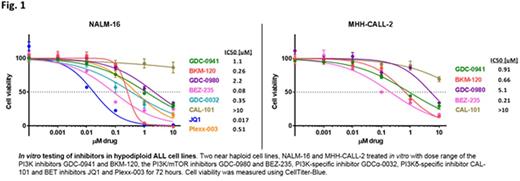Abstract
Introduction: Hypodiploid acute lymphoblastic leukemia (ALL) is a rare, high-risk subtype of B-ALL associated with poor outcome. Genomic analysis of over 130 Hypodiploid ALL patients defined the distinct genomic landscape of this disease, defining two principal subtypes including Ras-activating alterations and IKZF3 loss in near haploid tumors (24-31 chromosomes) and mutation of TP53 coupled with homozygous IKZF2 loss in low hypodiploid tumors (32-39 chromosomes). New therapies are needed to improve outcome of this disease, necessitating preclinical studies in hypodiploid tumors in vitro, ex vivo and in vivo.
Hypothesis: The observation of frequent Ras pathway activating mutations in hypodiploid ALL tumors, as well as increased phosphorylation of downstream Ras signaling targets, suggests that these tumors may be susceptible to PI3K/MEK inhibition. Ras signaling target activation was observed in hypodiploid tumors irrespective of mutational status. Here we used cell lines and representative xenograft models to explore the therapeutic efficacy of inhibiting PI3K/MAPK signaling in hypodiploid ALL.
Methods: The near haploid cell lines NALM-16 and MHH-CALL-2 and eight patient-derived xenograft (PDX) models (four near haploid and four low hypodiploid) were selected for preclinical studies. Xenografts were representative of the most common genomic lesions observed in hypodiploid ALL patients, including deletion of NF1, PAG1 and IKZF3 in near haploid and mutation of TP53 and IKZF2 deletion in low hypodiploid (Holmfeldt et al. Nat Genet 2013; Mullighan et al. Blood 2015). Next-gen sequencing of xenograft and diagnosis tumor DNA confirmed the presence of key genetic alterations in the xenografts. A lentiviral vector was used for stable expression of luciferase in xenograft tumors for in vivo disease burden monitoring. Cell lines were treated in vitro with PI3K, mTOR, MEK, CDK4/6 and BET inhibitors either as single agents, inhibitor combinations or combined with chemotherapeutic agents. Xenografts were treated ex vivo with single agents and in vivo with PI3K and MEK inhibitors with or without chemotherapy.
Results: NALM-16 and MHH-CALL-2 cell lines were most sensitive to PI3K, mTOR and BET inhibitors with IC50 values in the sub-micromolar range (Fig. 1).Treatment of xenografts ex vivo showed near haploid and low hypodiploid tumors to be four-fold more sensitive to pan-PI3K inhibitors and PI3K/mTOR dual inhibitors compared to PI3K α and d isoform-specific inhibitors. Near haploid and low hypodiploid xenografts were sensitive to MEK and BET inhibition ex vivo, but MEK inhibitors showed weak activity in the near haploid cell lines. Treatment with CDK4/6 inhibitors either as single agents or in combination with MEK inhibitors revealed minimal efficacy. Changes in cell signaling upon treatment was assayed by phosphoflow (Fig. 2). Akt and Erk1/2 phosphorylation was variable between tumors, whereas 4E-BP1 and S6 phosphorylation was consistently elevated, suggesting strong signaling through mTOR pathways. Pan-PI3K and PI3K/mTOR dual inhibitors showed potent activity against hypodiploid ALL tumors in vitro and ex vivo, however PI3K inhibition alone was insufficient to eliminate tumors in vivo. Substantial weight loss in mice treated with PI3K/mTOR dual inhibitors limited prolonged study in vivo. MAPK inhibition showed activity in both near haploid and low hypodiploid tumors ex vivo and displayed a modest reduction in tumor growth as a single agent in vivo. Combining the MEK inhibitor GDC-0973 with dexamethasone treatment increased efficacy, but induced significantly more weight loss than either monotherapy.
Conclusion: Treatment of hypodiploid cell lines and xenografts in vitro and ex vivo, respectively, with PI3K and MEK inhibitors showed promising results, however the anti-tumor effect in vivo appeared mostly cytostatic and inhibitors were not sufficient as single agents to kill the tumor cells. MEK inhibitors showed stronger activity than PI3K inhibitors on xenografts in vivo and ex vivo, but this was not significantly increased when combined with dexamethasone treatment. The notable resistance of hypodiploid cells to dexamethasone may underlie this limited efficacy in addition to the increase in GDC-0973 clearance observed upon combination. Our findings also highlight the need to consider the PK properties of agents in the preclinical setting, particularly in combinations.
No relevant conflicts of interest to declare.
Author notes
Asterisk with author names denotes non-ASH members.



This feature is available to Subscribers Only
Sign In or Create an Account Close Modal